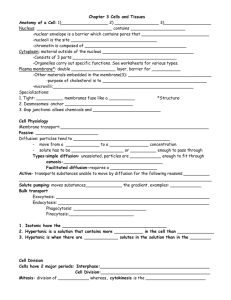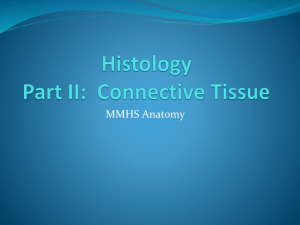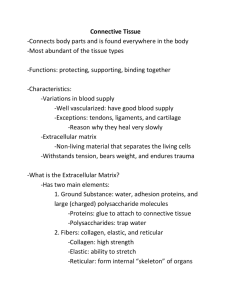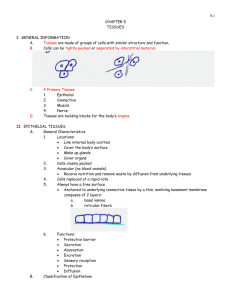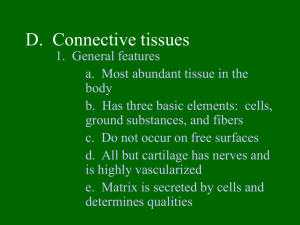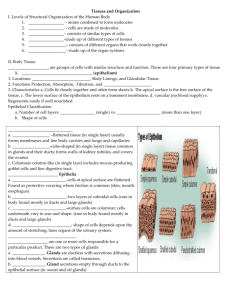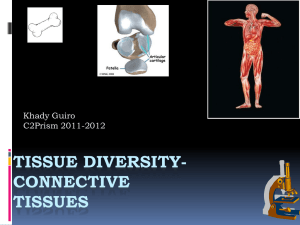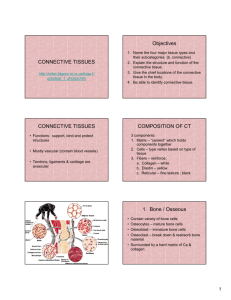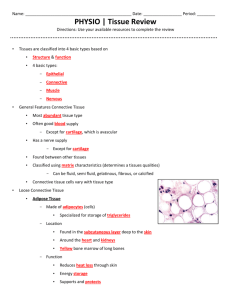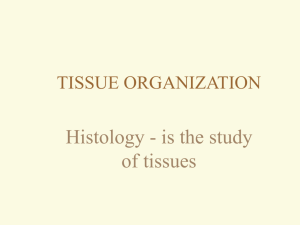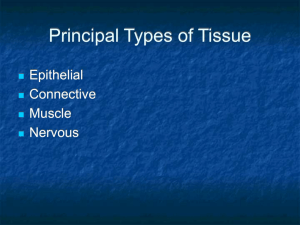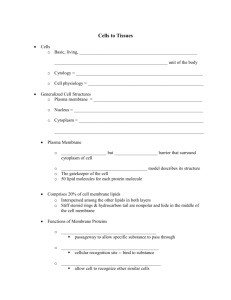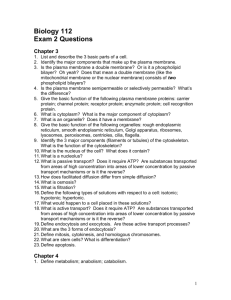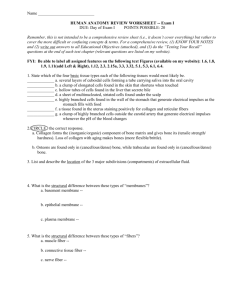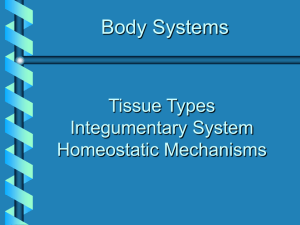Chapter 3 Cells and Tissues
advertisement
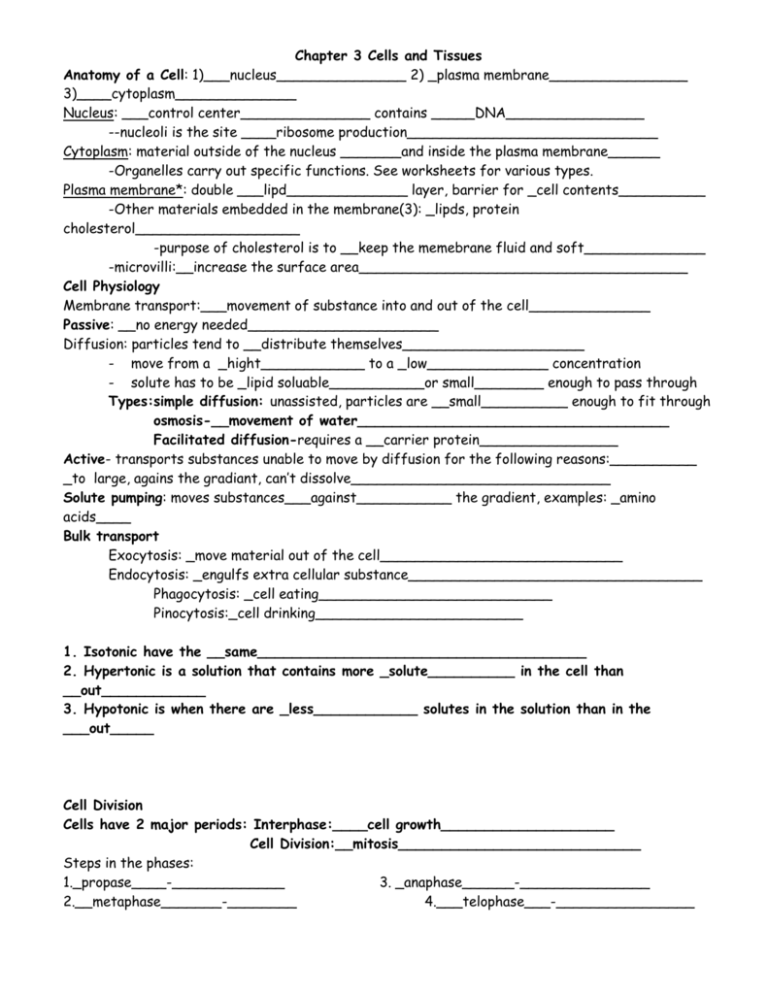
Chapter 3 Cells and Tissues Anatomy of a Cell: 1)___nucleus_______________ 2) _plasma membrane________________ 3)____cytoplasm______________ Nucleus: ___control center_______________ contains _____DNA________________ --nucleoli is the site ____ribosome production_____________________________ Cytoplasm: material outside of the nucleus _______and inside the plasma membrane______ -Organelles carry out specific functions. See worksheets for various types. Plasma membrane*: double ___lipd______________ layer, barrier for _cell contents__________ -Other materials embedded in the membrane(3): _lipds, protein cholesterol___________________ -purpose of cholesterol is to __keep the memebrane fluid and soft______________ -microvilli:__increase the surface area______________________________________ Cell Physiology Membrane transport:___movement of substance into and out of the cell______________ Passive: __no energy needed______________________ Diffusion: particles tend to __distribute themselves_____________________ - move from a _hight____________ to a _low______________ concentration - solute has to be _lipid soluable___________or small________ enough to pass through Types:simple diffusion: unassisted, particles are __small__________ enough to fit through osmosis-__movement of water____________________________________ Facilitated diffusion-requires a __carrier protein________________ Active- transports substances unable to move by diffusion for the following reasons:__________ _to large, agains the gradiant, can’t dissolve______________________________ Solute pumping: moves substances___against___________ the gradient, examples: _amino acids____ Bulk transport Exocytosis: _move material out of the cell____________________________ Endocytosis: _engulfs extra cellular substance__________________________________ Phagocytosis: _cell eating___________________________ Pinocytosis:_cell drinking________________________ 1. Isotonic have the __same______________________________________ 2. Hypertonic is a solution that contains more _solute__________ in the cell than __out____________ 3. Hypotonic is when there are _less____________ solutes in the solution than in the ___out_____ Cell Division Cells have 2 major periods: Interphase:____cell growth____________________ Cell Division:__mitosis____________________________ Steps in the phases: 1._propase____-_____________ 3. _anaphase______-_______________ 2.__metaphase_______-________ 4.___telophase___-________________ Role of RNA Acts as a decoder for the DNA tRNA: _transfers___________ amino acids to ribosome to build protein rRNA: helps form the __proteins___________________________________________ mRNA: carries the instructions for ___transfer______________ Transcription: _transfer__________ of information from _DNA_____ base sequence to the complimentary base sequence of _mRNA_________ Translation: base sequence of a __nucleic acid_____________ is ____amino acid Tissues: Four types: 1. __Epithelial_______________ 2. _connective__________________3. __muscular___________ 4. __nervous______ Epithelial is found in body covering_____ and _lining______ also, __glandlike_____________ tissue Function include: __protection, absorption,filtration, secretion_____________________ Characteristics: -_cells fit closely______________ together - Tissues always have _one free layer_________________________ - __avascular__________________ (no blood supply) - regenerate __easily if nourished_____________________ Draw what simple means: Draw what stratified means: ~Simple squamous: single layer of __flat___________ Forms membranes: examples of body parts it lines____cavities________________ ~Simple cuboidal: single layer of _cubes_________________ Common in glands______, found in __kidney_______ and ovaries ~Simple columnar: single layer of _tall cells_____________ Cells usually produce __mucus_________, typically found in __digestive tract ~Pseudostratified: single layer, but _some cells are shorter_____ Ciliated such as in the _respiratory tract_______________ Functions: _absorb______________ or __secrete____________ ~Stratified squamous: cells __free at edges and flat________________________ Locations: __skin mouth, esophagus____________ ~Transitional epithelial: depends on __stretching_____________________ lines the __bladder_______________ Connective tissue is found _everywhere___________________ in the body Functions: 1.binds _body tissues together___________________ 2. Supports __body____________ 3. Provides ______ Characteristics: variations in _blood supply______ and extra cellular matrix____ nonliving material Why do you choose a broken bone over a torn ligament? __better blood supply____ (Matrix is everything but the cell; surrounding material + fibers) Types of Connective Tissue 1. Bone (_osseous_____________): is used to _support body_________________ -Composed of bones in cavities called _lacunae________________, a very hard _matrix of calcium_, and large numbers of _college fibers______________________. 2. Cartilage is less _hard__ and more _rubbery__________ than _bone____________. a. Fetal skeleton is _hyaline cartilage_____, also found in the voice box and attaches the ribs -Composed of ____collagen___________ and _rubbery matrix_______________ b. Ear is made from _elastocartilage____________________ which provides ___elasticity________________ c. Fibrocartilage is not stretchy but highly compressable________________, forms discs in knee and 3. Dense connective tissue: main matrix is ___collegen______________________________. -Examples: _tendons__________: muscles to _bone___ Ligament: __bone to _bone___ Loose Connective Tissue 4. Areolar tissue: soaks up _excess fluids_______________ and causes an edema; “Glue” holds all organs in place. Contains many fibers through a loose network. 5. Adipose: cells contain _fat____________________________. -Functions: _insulate__________ the body, protect______________ some organs, _fuel storage________________ -cell type: adipocytes (chicken wire appearance) 6. Reticular: ___delicate network of fibers_________________________________ -Forms a _stroma________, which supports free blood cells. Found in lymph nodes and spleen_____ 7. Blood: surrounded by a __fluid__________________________ called _matrix_________. -Consists of protein fibers which are visible __during clottin_______________. -__transports___________ nutrients, gases, and wastes throughout the body. Muscle Tissue are specialized to contract____________ or _relax_________ to produce __movement___________. 1. skeletal ____ can be controlled voluntarily____________, cells are _striated__________, attach to _connective tissue_____________ Have more than _1______ nuclei. 2. _cardiac____________ found only in the __heart__________, cells attach to _other cardic cells__, functions involuntary, cells are __striated______________ and have __1___ nucleus. 3. Smooth muscles are __involuntary________________, surround __organs_______, attach to __other smooth muscle_____________, no striations and have __1____ nucleus. An example _stomach_______________ Nervous Tissue consists of __neurons and support cells________________. -Functioning: __irriability_____ and _conductivity____ sends impulses to rest of body
